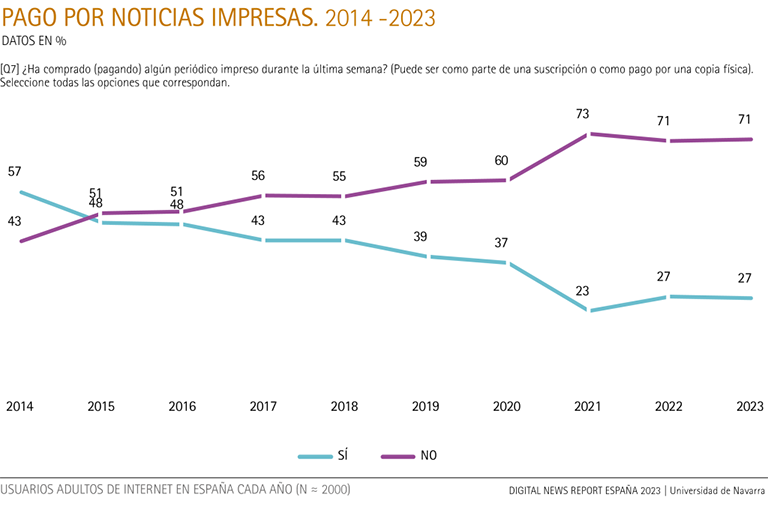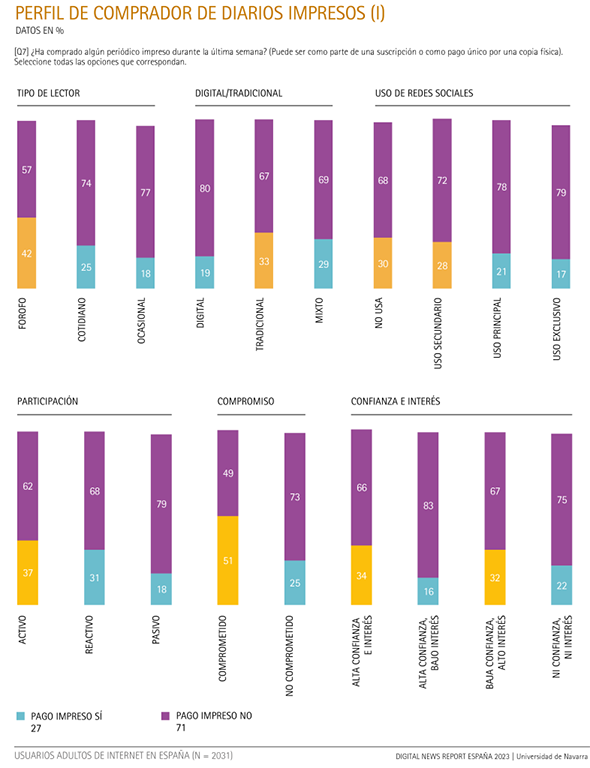What seemed anecdotal seems to have become something stable: around 27% of Spaniards surveyed said they had paid for printed news in the week prior to survey. And with 2023 it is now three consecutive years in which the figure for paying for printed information is around 25%. This is a change from the downward trend observed from 2014 to 2021 (see graph), the year in which the figure bottomed out, undoubtedly due to the influence of the pandemic and the temporary closure of outlets.
It is true that the proportion of buyers is still well below previous figures and that the recovery is modest compared to the general long-term decline of the last decade. However, it is surprising that, in a generalized change in the news consumption habits of Spaniards, with a clear shift towards digital news sources -new and traditional- there persists a group of irreducibles who continue to buy printed information.

The profile print news buyers' news feed
What does profile look like for those who continue to buy print news? Analysis of the data reveals some interesting trends. First, contrary to popular opinion, those under 45 tend to buy more print news (32%) than those over 45 (23%). And not only that, age also influences the subject of payment that is usually made. As can be seen in the graph, the younger age groups have a greater propensity to pay via postal subscription (11% vs. 4% of those older than that age) while the older age groups tend to buy at the newsstand (14%). By gender, there are also significant differences: 34% of men report having bought printed news in the week prior to survey compared to 20% of women.

Apart from the sociodemographic variables, print news buyers are readers who could be considered news fans, i.e., they are intensively and regularly informed. Forty-two percent of this group purchased print news the week prior to survey, suggesting that this group of readers is highly engaged with current affairs and continues to value the experience of reading news in print format, despite the growing availability of digital news. In contrast, those occasional readers, who inform themselves sporadically, are the least likely to purchase print news (18%). Finally, those who consume news on a regular but not necessarily intensive basis also show some propensity to purchase printed information (25%), which could indicate that they are diversifying their news sources and do not rely exclusively on digital newspapers to stay informed.
In fact, when analyzing the preferences of print news buyers in Spain in terms of consumption of digital or traditional formats, it is not surprising to find that those who prefer traditional formats tend to buy print news more than those who prefer digital formats (33% vs. 19%, respectively). Finally, 29% of respondents who use a combination of digital and traditional news sources purchased a print newspaper in the week prior to survey. This suggests that this group of news consumers continues to see value in print newspapers, even while also consuming news online.
Given that social networks are the primary news channel for many respondents, it was of interest to know if there are differences in their use among those who report buying print news. The data suggest that the relevance of print newspapers seems to decrease as reliance on social networks for news increases. Thus, 30% of respondents who do not use social networks to obtain news purchased print news. This suggests that print newspapers remain an important news source for those who do not use social networks to obtain information or for those who use them secondarily (28%). Against them, only 17% of respondents who use social networks as their only news source purchased print information in the week prior to survey.

Active, engaged and interested, but not necessarily confident, readers
The data provided offers an insight into the participation of print newspaper buyers in Spain in terms of their interaction with the news. As we will see, the analysis suggests that active participation in the discussion and exchange of news is more associated with a greater likelihood of buying print news. Thus, 37% of active readers bought printed information, compared to 18% of passive readers, who are informed but do not actively participate in public discussion.
In addition to being participative, readers who buy print news are characterized by a greater commitment or engagement with their usual news sources: 51% of these committed readers purchased print news compared to 25% of readers with a low level of commitment to their media.
Nor is it surprising that this subject of readers shows a high interest in news. Thirty-four percent of respondents with high trust and high interest in news bought print news in the week prior to the survey survey. But even among those very interested but usually distrustful of news, the percentage buying print news is relatively high (32%), showing that high interest can motivate the purchase of print news, even if trust in news is leave. In contrast, only 16% of respondents with high trust but low interest in news bought printed information.
At summary, the print news buyer in Spain tends to be an intensive and regular news reader, who values reading news in print format despite the increase in digitization. They tend to prefer traditional formats over digital and tend to diversify their news sources. In addition, these buyers are characterized by active participation in news discussions, and strong engagement with their usual news sources. Although trust in news can be leave, their high interest may motivate the purchase of print news.